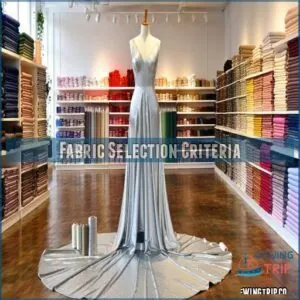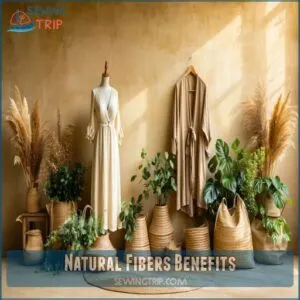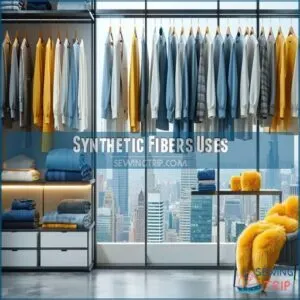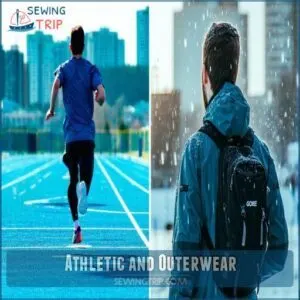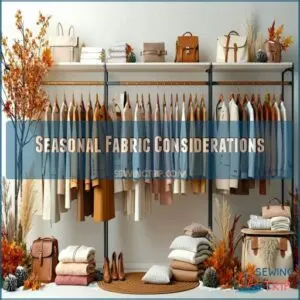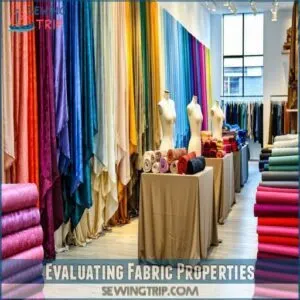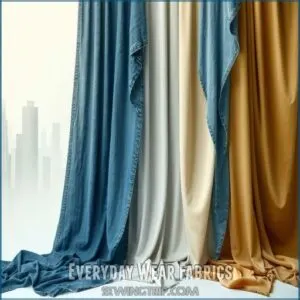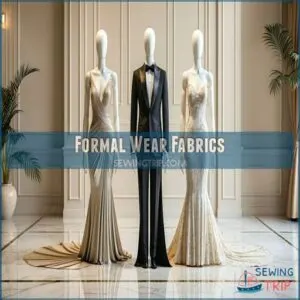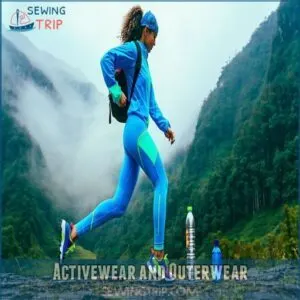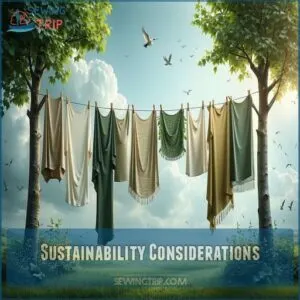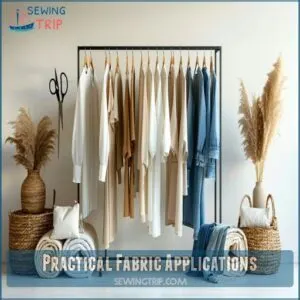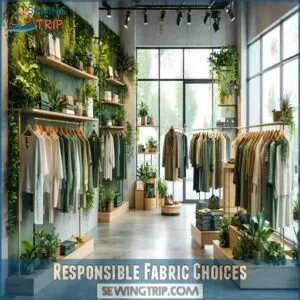This site is supported by our readers. We may earn a commission, at no cost to you, if you purchase through links.
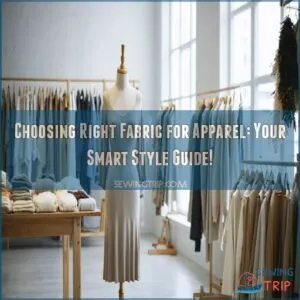 When choosing the right fabric for apparel, you’ll want to play fabric detective! Your mission: match fabric properties to your garment’s purpose.
When choosing the right fabric for apparel, you’ll want to play fabric detective! Your mission: match fabric properties to your garment’s purpose.
Natural fibers like cotton and wool offer breathability and comfort, while synthetics like polyester bring durability and easy care.
Consider your clothing’s function—workout gear needs moisture-wicking performance, while formal wear craves elegance.
Texture, stretch, and drape matter too; they’re the unsung heroes of clothing comfort.
Pro tip: don’t just feel the fabric, imagine how it’ll perform. Lightweight linens for summer heat, cozy wools for winter chills. Your perfect fabric isn’t just about looks—it’s about how it makes you feel.
Table Of Contents
Key Takeaways
- You’ll want to match fabric properties directly to your garment’s purpose, considering breathability, durability, comfort, and performance for each specific clothing type.
- Your fabric selection isn’t just about looks – it’s a strategic decision that impacts how your clothing will feel, perform, and last through countless wears and washes.
- You can maximize your wardrobe by understanding how different fabrics perform in various conditions, from moisture-wicking synthetic blends for athletics to breathable natural fibers for everyday comfort.
- You’ll make smarter clothing choices by evaluating key fabric characteristics like drape, texture, stretch, and care requirements before making a final selection.
Fabric Selection Criteria
When you’re picking fabric for your next fashion project, you’ll want to evaluate more than just looks – fabric performance is key to creating clothing that feels as good as it looks.
Your fabric choice impacts everything from comfort and durability to how your garment will perform in different environments.
So understanding selection criteria is your secret weapon in creating stylish, functional apparel.
Breathability and Moisture-Wicking
Ever wonder why some clothes feel like a second skin while others leave you feeling like you’re in a sauna? Breathability and moisture-wicking are your secret weapons for comfort.
Check out these fabric game-changers:
- Air circulation prevents heat buildup
- Sweat evaporation keeps you dry
- Moisture management reduces bacterial growth
- Lightweight fabrics enhance wicking performance
- Natural fibers excel in breathability
Choose wisely – your comfort depends on it!
Softness and Comfort
Understanding fabric softness is crucial for comfort. Natural fibers like cotton and merino wool offer a superior hand feel, breathability, and gentle touch.
Achieving ideal comfort involves selecting high quality fabric that balances durability and elegance.
Your comfort depends on the interaction between fabric properties and skin sensitivities, creating a personal temperature regulation system.
Durability and Longevity
Durability isn’t just a buzzword – it’s your fabric’s superpower in battling wear and tear.
Check out these key durability factors:
- Tensile strength determines how much stress your fabric can handle
- Fabric weave impacts resistance to abrasion
- Fiber composition influences overall garment lifetime
- Martindale test measures long-term performance potential
Choosing a robust fabric means investing in clothes that stick around, outlasting trends and keeping your style game strong.
Color Fastness and Aesthetic
Color fastness—the chameleon of fashion—determines how your favorite shirt keeps its vibrant personality through countless washes.
Prioritize fabrics with superior color retention and dye methods that preserve visual appeal when selecting apparel.
Your fabric’s aesthetic impact depends on its ability to maintain rich, consistent colors, making color fastness a critical factor in long-lasting, stylish garments.
Natural Fibers Benefits
When you’re choosing fabric for your next wardrobe piece, natural fibers like cotton, wool, and silk can be your best allies in comfort and style.
These breathable, luxurious materials aren’t just about looking good—they’ll keep you cool, regulate temperature, and offer unmatched softness that’ll make you feel confident all day long.
Cotton and Linen Characteristics
Cotton, a superstar in the fabric world, makes up almost a third of global textile fibers. Its softness and unbeatable absorbency make it ideal for everyday wear.
Linen offers superior breathability and a crisp feel, making it perfect for warmer weather.
Understanding the cotton vs linen difference allows you to choose the perfect fabric for your needs. Both of these natural fibers have unique properties that can elevate your wardrobe.
Wool and Silk Properties
Exploring luxurious natural fibers reveals the magical properties of wool and silk that elevate your wardrobe. These premium materials bring unparalleled sophistication to apparel through unique fabric characteristics.
- Wool delivers remarkable warmth with incredible temperature regulation.
- Silk provides unmatched elegant drape and smooth texture.
Natural fibers showcase exceptional breathability and moisture management. Microscopic fiber structures enable superior fabric performance.
Blended fabrics maximize inherent wool and silk advantages.
Natural Fiber Care Requirements
After exploring wool’s luxurious warmth and silk’s smooth elegance, you’ll want to master their care. Natural fibers demand thoughtful maintenance to preserve their unique properties.
Check out this quick care guide to keep your precious pieces looking pristine:
| Fabric Type | Washing | Drying |
|---|---|---|
| Wool | Cold water, gentle cycle | Flat dry, away from direct heat |
| Silk | Hand wash, mild detergent | Air dry, avoid wringing |
Treat these fabrics right, and they’ll reward you with lasting beauty.
Synthetic Fibers Uses
You’ll love how synthetic fibers like polyester and nylon revolutionize your wardrobe with their incredible durability and low-maintenance charm.
Get ready to discover fabrics that’ll keep you comfortable, looking sharp, and spending less time on garment care – these high-performance materials are your new style sidekicks!
Polyester and Nylon Applications
From silk’s luxurious embrace, we shift gears to powerhouse synthetic fabrics. Polyester and nylon reign supreme in modern apparel, offering unmatched versatility.
Here’s why they’re game-changers:
- Lightweight performance in athletic wear
- Exceptional durability for everyday clothing
- Rapid moisture-wicking capabilities
These technical fabrics transform how you dress, blending cutting-edge science with style that moves with you.
Synthetic Fiber Durability
Synthetic fibers often prove incredibly tough, outperforming natural materials in wear resistance.
Your favorite polyester and nylon garments boast remarkable fabric strength, engineered to withstand repeated stress and environmental challenges.
Material testing reveals these synthetic blends maintain exceptional durability, ensuring clothing retains shape and performance through countless wears and washes.
Easy Care and Maintenance
Convenience speaks volumes regarding synthetic fabric maintenance.
You’ll love how polyester and nylon laugh off tough stains and wrinkles, making care a breeze.
Quick-dry properties mean less time wrestling with washing instructions and more time enjoying your clothes.
Simple machine wash, tumble dry, and you’re set – these fabrics are your low-maintenance fashion heroes.
Fabric Types and Purposes
When choosing the right fabric for your apparel, you’ll want to take into account the specific purpose and performance characteristics that’ll make your garment shine.
From casual comfort to professional polish, understanding fabric types lets you select materials that’ll match your style, activity, and comfort needs perfectly.
Casual and Formal Wear
After exploring synthetic fibers‘ versatility, let’s zoom in on fabric trends that make or break your wardrobe.
Choosing between casual and formal wear isn’t just about looks—it’s clothing psychology in action. Your dress codes demand smart fabric selection, balancing comfort with style.
Understanding wedding dress codes is essential for special occasions. From relaxed cotton tees to sophisticated silk blazers, your apparel fabric choices speak volumes about your personal brand.
Athletic and Outerwear
When gearing up for athletics or battling the elements, your fabric choice becomes your secret weapon.
Moisture-wicking polyester and nylon dominate sportswear technology, pulling sweat away while keeping you cool.
For outerwear, thermal insulation reigns supreme – think waterproof Gore-Tex or breathable synthetic blends that shield you from wind and rain without sacrificing comfort or performance.
Seasonal Fabric Considerations
From athletic gear to beating the seasonal style game, your fabric choices can make or break your comfort zone.
Mastering seasonal fabric selection is like having a wardrobe superpower.
Check out these must-know seasonal textile tips:
- Winter fabrics scream warmth with wool and cashmere
- Summer textiles breathe easy with lightweight cotton and linen
- Autumn wear loves layerable, versatile blends
- Thermal insulation matters more than you think
- Seasonal colors can amplify your fabric’s mood
Your apparel fabric choices are your style’s secret weapon.
Evaluating Fabric Properties
When choosing your perfect fabric, understanding its properties isn’t just technical—it’s your secret weapon in crafting garments that look and feel amazing.
You’ll want to master the art of evaluating drape, texture, stretch, and durability to transform your clothing from ordinary to extraordinary.
Drape and Structure
Ever wondered why some clothes look like they’re dancing and others hang stiffly?
Drape isn’t just about fabric – it’s about fabric flow and textile geometry that transforms your garment’s silhouette.
Check out how different fabrics behave: Understanding silk fabric properties is essential for making informed decisions.
| Fabric Type | Drape Characteristics | Best Used For |
|---|---|---|
| Silk | Fluid, soft fall | Evening gowns |
| Denim | Structured, rigid | Structured jackets |
| Jersey | Moderate flow | Casual wear |
Master your fabric‘s personality, and you’ll nail the perfect look every time.
Texture and Hand Feel
Your fabric’s texture speaks volumes before you even slip it on. The hand feel of a textile transforms an ordinary garment into a sensory experience that defines comfort and style.
Texture tells a story through:
- Silky whispers against your skin
- Rough denim’s rebellious edge
- Soft cotton’s gentle embrace
- Luxurious wool’s warm caress
- Crisp linen’s invigorating touch
Understanding surface quality elevates fabric selection from mere clothing to personal expression.
Stretch and Recovery
Feel the fabric’s personality through its stretch and recovery – it’s like a fabric’s secret superpower!
Elastic properties reveal how your clothing moves with you, whether you’re reaching for that top shelf or dancing all night.
Understand fabric tension and stretch limits to pick garments that keep their shape and comfort, making your style as flexible as your lifestyle.
Matching Fabric to Garment
You’ll want to match your fabric as carefully as a chef selects ingredients for a perfect recipe, ensuring each garment looks and feels exactly right.
From breathable cotton for everyday comfort to luxurious silk for formal occasions, your fabric choice can transform an ordinary outfit into a stunning style statement.
Everyday Wear Fabrics
Almost every wardrobe craves versatile, comfortable everyday wear fabrics that stand up to daily life’s challenges.
Picking the right material makes all the difference in your clothing comfort and style. Understanding fabric dictionary terms is essential for making informed choices.
Here’s what makes everyday fabrics rock:
- Cotton breathes like a champ, keeping you cool
- Jersey knits offer stretch and supreme comfort
- Denim delivers durability with classic attitude
- Lightweight blends balance performance and style
Formal Wear Fabrics
You’ve mastered everyday wear fabrics, now let’s elevate your style game with formal wear textiles that scream luxury.
From wedding gowns to red carpet looks, your fabric choice makes or breaks the outfit.
Check out this quick guide to selecting showstopping luxury textiles that’ll turn heads and command respect.
| Fabric Type | Characteristics |
|---|---|
| Silk | Smooth, elegant, drapes beautifully |
| Wool Blend | Structured, holds shape perfectly |
| High-End Polyester | Wrinkle-resistant, affordable luxury |
Activewear and Outerwear
When selecting fabrics for activewear and outerwear, performance becomes your ultimate style compass. Your dream materials should deliver more than just looks – they’re your performance partners.
- Moisture-wicking synthetics that laugh at sweat
- Thermal-protective layers blocking winter’s coldest punches
- Water-resistant shells keeping you dry during outdoor adventures
Polyester and nylon reign supreme in athletic performance, offering durability, flexibility, and cutting-edge functionality for serious movers and outdoor enthusiasts.
Sustainability Considerations
When you’re choosing fabric, you’re not just selecting a material—you’re making a statement about environmental responsibility and ethical fashion.
Your fabric choices can substantially reduce your carbon footprint, support sustainable practices, and contribute to a more responsible global textile industry.
Eco-Friendly Fibers
Ever wondered how your clothing choices can save the planet? Eco-friendly fibers are your secret weapon in sustainable fashion. These innovative materials slash environmental impact while keeping you stylish and comfortable.
| Fiber Type | Key Benefits |
|---|---|
| Organic Cotton | Reduces pesticide use |
| Hemp | Low water consumption |
| Bamboo | Rapid renewable growth |
| Tencel | Minimal chemical processing |
| Flax (Linen) | Biodegradable and durable |
Recycled Materials and Biodegradable
Wondering how your wardrobe can be a planet-friendly game-changer? Recycled materials like polyester from plastic bottles and biodegradable fabrics such as Tencel transform textile waste into stylish solutions.
These innovative fabric blends reduce environmental impact, offering sustainable alternatives that break down naturally without compromising quality or comfort.
Your fashion choices can literally save the planet, one garment at a time.
Ethical Production and Low-Impact
Sustainable fashion isn’t just about materials—it’s about the human impact. Look for brands championing fair labor practices and transparent supply chains.
When you’ve explored recycled materials, the next step is ethical production.
Choose textiles that minimize carbon footprint, conserve water, and support fair trade. Your clothing choices can drive positive change in the global fashion ecosystem.
Practical Fabric Applications
When selecting fabric for your apparel, you’ll want to evaluate your garment’s specific purpose, from everyday comfort to special occasions.
Your fabric choice isn’t just about looks—it’s a strategic decision that impacts how your clothing will feel, perform, and last through countless wears and washes.
Garment Functionality and Purpose
Zero in on garment functionality to nail your fabric choice like a pro. Your fabric’s performance hinges on its intended use, making selection essential for apparel success.
- Performance trumps pretty – choose function first
- Comfort is your secret weapon
- Durability speaks louder than trends
Match fabric to your specific lifestyle needs. Invest in quality that works hard for you.
Select smartly, sew confidently.
Desired Look and Feel
After nailing your garment’s functionality, let’s talk fabric’s visual magic. Your chosen fabric’s texture whispers volumes about style and aesthetic.
Smooth silk screams elegance, while crisp cotton says casual cool. The desired drape can make or break your look – flowing or structured, each fabric tells a unique story about your personal style and how you want the world to see you.
Understanding the fabric drape and texture basics is essential to create a garment that looks great and also feels amazing to wear.
Seasonal and Occasional Wear
When summer hits, breathable linens and lightweight cotton become your best friends for staying cool and stylish.
Winter demands cozy wool and insulating synthetics that trap warmth without weighing you down. Special occasions call for luxurious silk or structured polyester blends that elevate your look.
For maximum comfort, selecting summer fabrics is essential during the warmer months. Your fabric choice isn’t just about comfort—it’s about making a statement across every season.
Responsible Fabric Choices
When you’re ready to make fashion choices that matter, understanding the environmental and social impact of your fabric selection becomes essential.
You’ll discover how your clothing decisions can support sustainable practices, reduce waste, and contribute to a more responsible fashion ecosystem.
Environmental Impact and Footprint
In fashion, your environmental impact is more than just a drop in the bucket. Understanding the carbon footprint of textile production can transform your wardrobe into a green statement.
Consider these eco-conscious fabric choices:
- Organic cotton reduces water consumption
- Recycled polyester minimizes waste
- Hemp offers low environmental stress
- Innovative biodegradable textiles break down naturally.
Your fabric decisions shape global sustainability.
Social Responsibility and Fair Trade
Reducing your carbon footprint isn’t just about eco-friendly materials—it’s about supporting human dignity. Fair trade certification means workers receive living wages, safe conditions, and respect.
By choosing brands committed to ethical sourcing, you’re casting a vote for positive change. Your fashion choices can empower communities and transform lives beyond the fabric’s threads.
Understanding sustainable fabric options is essential in making informed decisions that promote both environmental and social responsibility. Fair trade certification ensures workers’ rights and well-being.
Continuous Education and Innovation
Every forward-thinking designer knows mastering fabric technology is your ticket to innovation.
Stay curious about emerging fiber technologies and immerse yourself in textile science forums that spark creativity.
Connect with sustainable design education platforms to keep your finger on the pulse of circular economy practices.
Your passion drives the future of fabric research and textile industry evolution.
Frequently Asked Questions (FAQs)
What are the factors to consider in choosing fabric for clothing?
Picture yourself torn between comfort and style—your fabric choice is your secret weapon.
Consider breathability, durability, purpose, and seasonality.
Weigh stretch, texture, and care requirements to craft a garment that’ll turn heads and feel like a second skin.
How do I choose the right fabric?
Begin by checking your garment’s purpose.
Consider breathability, durability, and comfort. Match fabric weight to the season, stretch to the design, and care requirements to your lifestyle.
Test fabric drape and feel before buying to guarantee the perfect match for your project.
What kind of fabric do I use for clothes?
Like a master painter selecting the perfect brush, you’ll want to match fabric to function.
Cotton breathes for casual wear.
Silk drapes elegantly for formal events.
Polyester stretches for activewear.
Wool warms you in winter’s chill.
How do designers choose fabric?
Designers blend art and science, selecting fabrics by analyzing purpose, performance, and aesthetic.
They consider drape, durability, texture, and comfort, matching material characteristics to garment style, seasonal needs, and intended use.
How do I prevent shrinkage when washing fabrics?
Check garment labels and pre-wash natural fibers before sewing to prevent unexpected size changes.
With 60% of fabric shrinkage caused by heat, you’ll want to wash clothes in cold water.
Use gentle cycles, and air dry or tumble dry on low heat.
Can I mix different fabric types together?
You can mix fabric types, but watch for compatibility! Consider weight, stretch, care instructions, and washing temperatures.
Some combos work magic, while others spell disaster.
Test a small section first to confirm harmony between different fabrics.
What fabric works best for sensitive skin?
Opt for ultra-soft, natural fabrics like organic cotton, bamboo, or silk.
These breathable materials minimize skin irritation, wick moisture, and feel gentle against sensitive skin, reducing the risk of allergic reactions or discomfort.
How expensive are high-quality clothing fabrics?
Fabric prices vary widely, from $5 to $500 per yard.
High-end materials like silk and cashmere cost a pretty penny. Premium cotton and wool blends offer quality without breaking the bank.
Your budget determines the fabric’s luxe factor.
Where can I learn fabric care techniques?
Want to master fabric care? Invest in a thorough fabric care guide and read garment labels carefully.
Check out online tutorials, such as YouTube channels and sewing blogs, which offer expert tips that’ll help you keep your clothes looking fresh and fabulous.
Conclusion
Ultimately, choosing the right fabric for apparel is like finding your perfect dance partner—it’s about harmony, performance, and comfort.
You’ve learned to match fabrics to function, balancing breathability, durability, and style.
Whether you’re picking cotton for casual wear or high-tech synthetics for workouts, your newfound fabric wisdom empowers smarter wardrobe choices.
Trust your instincts, feel the fabric, and remember: the right textile transforms clothing from mere coverage to a confident expression of you.
- https://theemergingdesigner.com/fashion-design-fabric-selection-guide/
- https://northshorecrafts.com/how-to-choose-fabric-for-clothing/
- https://allaboutfabrics.com/blogs/news/the-ultimate-guide-to-choosing-fabric-for-apparel-sewing
- https://searchforfabric.com/blogs/search-for-fabric-blog/the-importance-of-high-quality-fabric-for-clothing-a-guide-to-elevating-your-wardrobe
- https://www.gelato.com/blog/best-fabric-for-t-shirts

